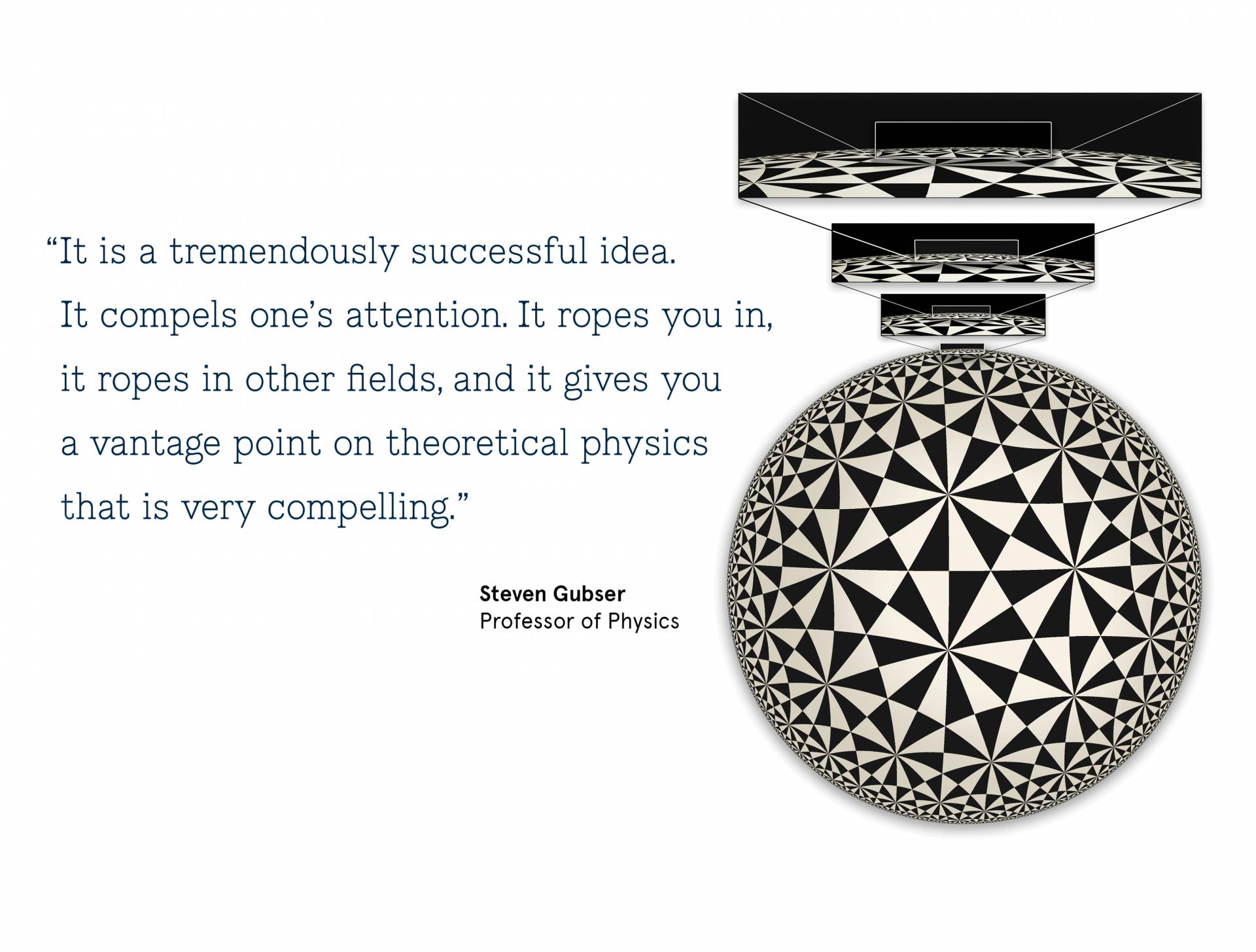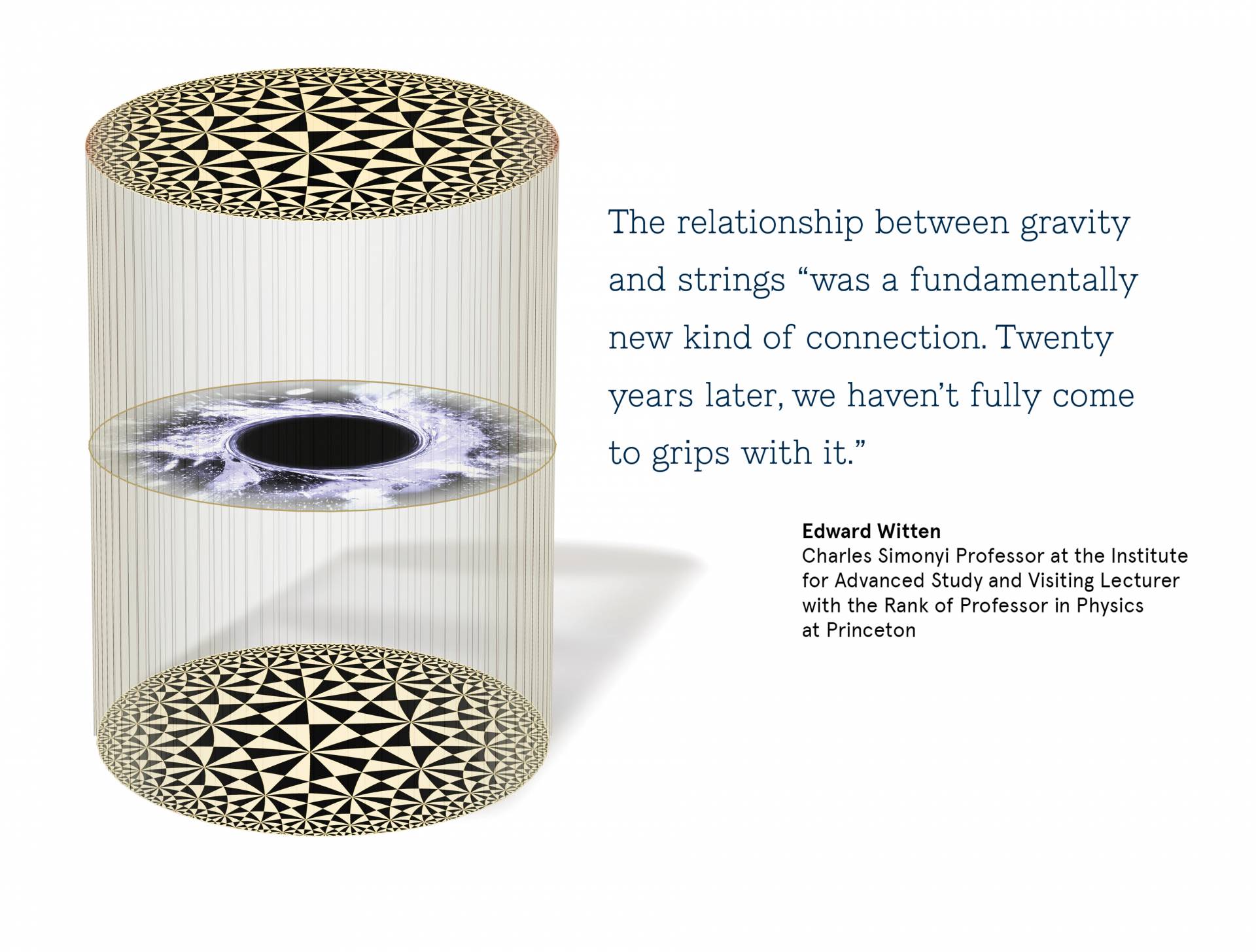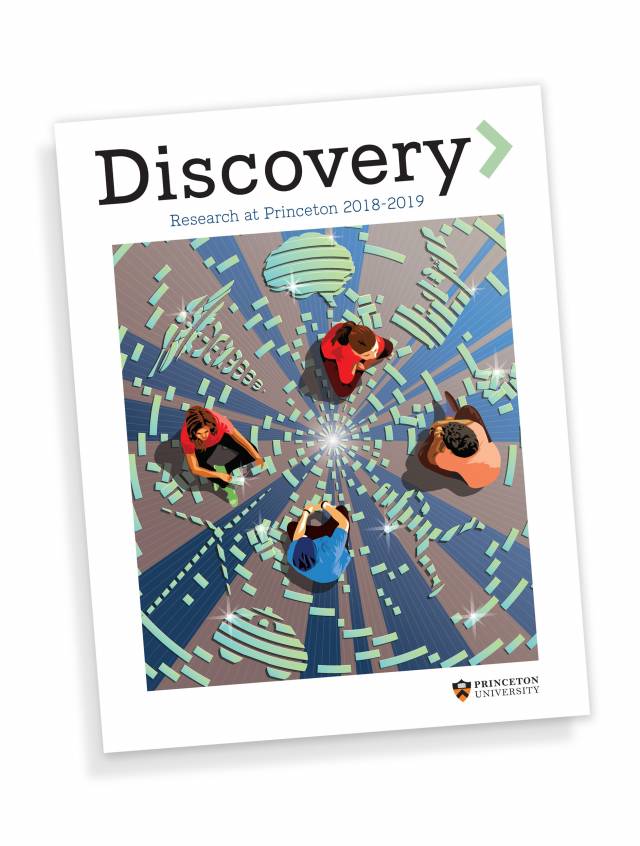Dec. 17, 2018 noon
Gravity, the force that brings baseballs back to Earth and governs the growth of black holes, is mathematically relatable to the peculiar antics of the subatomic particles that make up all the matter around us.
Albert Einstein’s desk can still be found on the second floor of Princeton’s physics department. Positioned in front of a floor-to-ceiling blackboard covered with equations, the desk seems to embody the spirit of the frizzy-haired genius as he asks the department’s current occupants, “So, have you solved it yet?”
Einstein never achieved his goal of a unified
theory to explain the natural world in a single, coherent framework.
Over the last century, researchers have pieced together links between
three of the four known physical forces in a “standard model,” but the
fourth force, gravity, has always stood alone.
No longer. Thanks to insights made by Princeton faculty members and others who trained here, gravity is being brought in from the cold — although in a manner not remotely close to how Einstein had imagined it.
Though not yet a “theory of everything,” this
framework, laid down over 20 years ago and still being filled in,
reveals surprising ways in which Einstein’s theory of gravity relates to
other areas of physics, giving researchers new tools with which to
tackle elusive questions.
The key insight is that gravity, the force that
brings baseballs back to Earth and governs the growth of black holes,
is mathematically relatable to the peculiar antics of the subatomic
particles that make up all the matter around us.
This revelation allows scientists to use one
branch of physics to understand other seemingly unrelated areas of
physics. So far, this concept has been applied to topics ranging from
why black holes run a temperature to how a butterfly’s beating wings can
cause a storm on the other side of the world.
This relatability between gravity and subatomic
particles provides a sort of Rosetta stone for physics. Ask a question
about gravity, and you’ll get an explanation couched in the terms of
subatomic particles. And vice versa.
“This has turned out to be an incredibly rich area,” said Igor Klebanov,
Princeton’s Eugene Higgins Professor of Physics, who generated some of
the initial inklings in this field in the 1990s. “It lies at the
intersection of many fields of physics.”
From tiny bits of string
The seeds of this correspondence were sprinkled
in the 1970s, when researchers were exploring tiny subatomic particles
called quarks. These entities nest like Russian dolls inside protons,
which in turn occupy the atoms that make up all matter. At the time,
physicists found it odd that no matter how hard you smash two protons
together, you cannot release the quarks — they stay confined inside the
protons.
One person working on quark confinement was Alexander Polyakov,
Princeton’s Joseph Henry Professor of Physics. It turns out that quarks
are “glued together” by other particles, called gluons. For a while,
researchers thought gluons could assemble into strings that tie quarks
to each other. Polyakov glimpsed a link between the theory of particles
and the theory of strings, but the work was, in Polyakov’s words,
“hand-wavy” and he didn’t have precise examples.
Meanwhile, the idea that fundamental particles
are actually tiny bits of vibrating string was taking off, and by the
mid-1980s, “string theory” had lassoed the imaginations of many leading
physicists. The idea is simple: just as a vibrating violin string gives
rise to different notes, each string’s vibration foretells a particle’s
mass and behavior. The mathematical beauty was irresistible and led to a
swell of enthusiasm for string theory as a way to explain not only
particles but the universe itself.
One of Polyakov’s colleagues was Klebanov, who
in 1996 was an associate professor at Princeton, having earned his Ph.D.
at Princeton a decade earlier. That year, Klebanov, with graduate
student Steven Gubser
and postdoctoral research associate Amanda Peet, used string theory to
make calculations about gluons, and then compared their findings to a
string-theory approach to understanding a black hole. They were
surprised to find that both approaches yielded a very similar answer. A
year later, Klebanov studied absorption rates by black holes and found
that this time they agreed exactly.
That work was limited to the example of gluons
and black holes. It took an insight by Juan Maldacena in 1997 to pull
the pieces into a more general relationship. At that time, Maldacena,
who had earned his Ph.D. at Princeton one year earlier, was an assistant
professor at Harvard. He detected a correspondence between a special
form of gravity and the theory that describes particles. Seeing the
importance of Maldacena’s conjecture, a Princeton team consisting of
Gubser, Klebanov and Polyakov followed up with a related paper
formulating the idea in more precise terms.
Another physicist who was immediately taken with the idea was Edward Witten of the Institute for Advanced Study
(IAS), an independent research center located about a mile from the
University campus. He wrote a paper that further formulated the idea,
and the combination of the three papers in late 1997 and early 1998
opened the floodgates.
“It was a fundamentally new kind of
connection,” said Witten, a leader in the field of string theory who had
earned his Ph.D. at Princeton in 1976 and is a visiting lecturer with
the rank of professor in physics at Princeton. “Twenty years later, we
haven’t fully come to grips with it.”

Two sides of the same coin
This relationship means that gravity and
subatomic particle interactions are like two sides of the same coin. On
one side is an extended version of gravity derived from Einstein’s 1915
theory of general relativity. On the other side is the theory that
roughly describes the behavior of subatomic particles and their
interactions.
The latter theory includes the catalogue of
particles and forces in the “standard model” (see sidebar), a framework
to explain matter and its interactions that has survived rigorous
testing in numerous experiments, including at the Large Hadron Collider.
In the standard model, quantum behaviors are
baked in. Our world, when we get down to the level of particles, is a
quantum world.
Notably absent from the standard model is
gravity. Yet quantum behavior is at the basis of the other three forces,
so why should gravity be immune?
The new framework brings gravity into the
discussion. It is not exactly the gravity we know, but a slightly warped
version that includes an extra dimension. The universe we know has four
dimensions, the three that pinpoint an object in space — the height,
width and depth of Einstein’s desk, for example — plus the fourth
dimension of time. The gravitational description adds a fifth dimension
that causes spacetime to curve into a universe that includes copies of
familiar four-dimensional flat space rescaled according to where they
are found in the fifth dimension. This strange, curved spacetime is
called anti-de Sitter (AdS) space after Einstein’s collaborator, Dutch
astronomer Willem de Sitter.
astronomer Willem de Sitter.
The breakthrough in the late 1990s was that
mathematical calculations of the edge, or boundary, of this anti-de
Sitter space can be applied to problems involving quantum behaviors of
subatomic particles described by a mathematical relationship called
conformal field theory (CFT). This relationship provides the link, which
Polyakov had glimpsed earlier, between the theory of particles in four
space-time dimensions and string theory in five dimensions. The
relationship now goes by several names that relate gravity to particles,
but most researchers call it the AdS/CFT (pronounced A-D-S-C-F-T)
correspondence.

Tackling the big questions
This correspondence, it turns out, has many
practical uses. Take black holes, for example. The late physicist
Stephen Hawking startled the physics community by discovering that black
holes have a temperature that arises because each particle that falls
into a black hole has an entangled particle that can escape as heat.
Using AdS/CFT, Tadashi Takayanagi and Shinsei
Ryu, then at the University of California-Santa Barbara, discovered a
new way to study entanglement in terms of geometry, extending Hawking’s insights in a fashion that experts consider quite remarkable.
In another example, researchers are using
AdS/CFT to pin down chaos theory, which says that a random and
insignificant event such as the flapping of a butterfly’s wings could
result in massive changes to a large-scale system such as a faraway
hurricane. It is difficult to calculate chaos, but black holes — which
are some of the most chaotic quantum systems possible — could help. Work
by Stephen Shenker and Douglas Stanford at Stanford University, along
with Maldacena, demonstrates how, through AdS/CFT, black holes can model
quantum chaos.
One open question Maldacena hopes the AdS/CFT
correspondence will answer is the question of what it is like inside a
black hole, where an infinitely dense region called a singularity
resides. So far, the relationship gives us a picture of the black hole
as seen from the outside, said Maldacena, who is now the Carl P.
Feinberg Professor at IAS.
“We hope to understand the singularity inside
the black hole,” Maldacena said. “Understanding this would probably lead
to interesting lessons for the Big Bang.”
The relationship between gravity and strings
has also shed new light on quark confinement, initially through work by
Polyakov and Witten, and later by Klebanov and Matt Strassler, who was
then at IAS.
Those are just a few examples of how the
relationship can be used. “It is a tremendously successful idea,” said
Gubser, who today is a professor of physics at Princeton. “It compels
one’s attention. It ropes you in, it ropes in other fields, and it gives
you a vantage point on theoretical physics that is very compelling.”
The relationship may even unlock the quantum
nature of gravity. “It is among our best clues to understand gravity
from a quantum perspective,” said Witten. “Since we don’t know what is
still missing, I cannot tell you how big a piece of the picture it
ultimately will be.”

Still,
the AdS/CFT correspondence, while powerful, relies on a simplified
version of spacetime that is not exactly like the real universe.
Researchers are working to find ways to make the theory more broadly
applicable to the everyday world, including Gubser’s research on
modeling the collisions of heavy ions, as well as high-temperature
superconductors.
Also on the to-do list is developing a proof of
this correspondence that draws on underlying physical principles. It is
unlikely that Einstein would be satisfied without a proof, said Herman Verlinde,
Princeton’s Class of 1909 Professor of Physics, the chair of the
Department of Physics and an expert in string theory, who shares office
space with Einstein’s desk.
“Sometimes I imagine he is still sitting there,” Verlinde said, “and I wonder what he would think of our progress.”
This article was originally published in the University’s annual research magazine Discovery: Research at Princeton.
